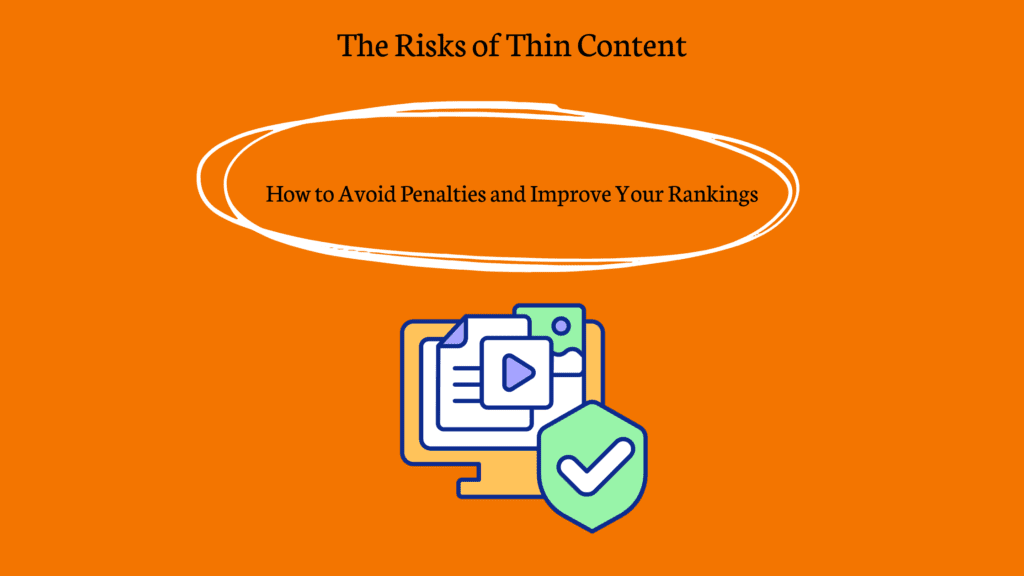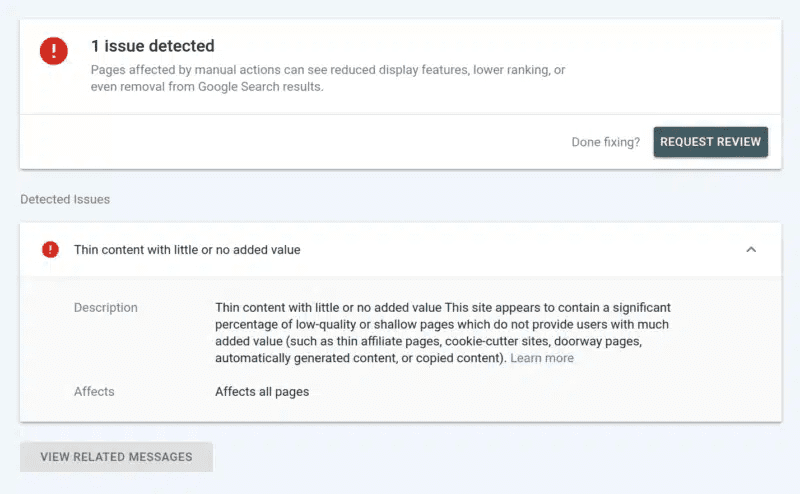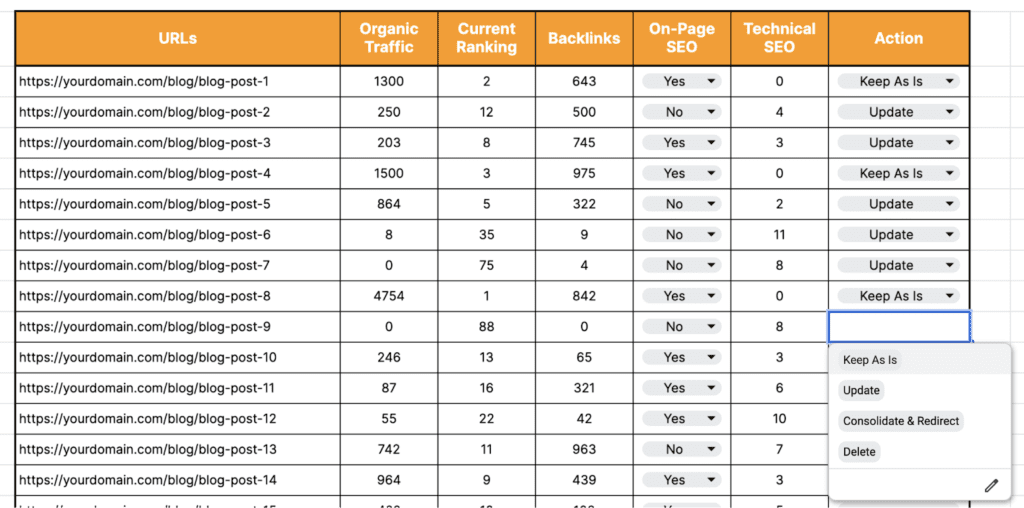
Are you facing roadblocks because you are not able to get thousands of monthly visitors to your website? And to solve this issue you have tried everything like SEO, backlinks, and a good UX/UI design. Then you need to check if your website has thin content.
If you are not aware of what thin content is then keep reading on. In this blog we will cover
- What is thin content?
- How to identify and remove it from your website.
We will also discuss how Google fixes thin content issues and why it doesn’t like thin content.
See, providing great and authentic content is how you reach new audiences and convert them into paying customers. But if you have thin content it is costing you more than you think.
Defining Thin Content
Any content on your website that offers little to no value to the readers is thin content. That’s it? Yes this thin content meaning may seem simple but the issue is big as it takes dedicated efforts to fix.
But Why Do I Avoid Thin Content on My Website?
Yes, this is a very good question. You should avoid thinking on your website because:
- it lowers your conversion rate
- it hurts your ability to attract new users and readers to the website
- It negativly impacts your ranking on Google SERP
- your Bounce rate becomes very high as you are not giving any value to the reader.
- and due to all these reasons the Domain Health of your website suffers greatly
Did you know? Low-quality pages receive 3x fewer backlinks than high-quality pages. (Source: Backlinko)
The question for you is – Can you afford such repercussions?
Reasons Why Google Dislikes Thin Content
The main goal of Google is to find the best answers for user’s queries. Google wants to find the kind of content that provides maximum value to its user’ssSearch intent. When your website has a lot of thin content, users will land on your page, but will not get high quality content. And the result will be they are searching again for that same information. This is something Google does not want for its users and that is why it does not like thin content.
How Google Solves the Problem of Thin Content
For those of you who didn’t know Google has systems in place to find and penalize thin content.
- The first method is releasing new algorithms with core updates and changing ranking systems.
- The second method is Google issues a manual penalty to websitees which have thin contact.
Let’s understand this one by one
Releasing new algorithms with core updates and changing the ranking systems.
As we all know, Google rolles out new SEO algorithms several updates in a year, some of them are major ones. It started with Panda, which was quite efficient in reducing thin content on websites. And with ranking systems Dev. Prioritize, they boost content that is focused on the users or readers for whom the content is written. Meaning the content should be high value, helpful and trustworthy for the people.
Websites lose an average of 45% of their traffic when they are penalized by Google. (Source: Search Engine Journal)
Penalty from Google due to thin content

Source Search Engine Land
Starting in 2013 Google’s Search Team started manually penalizing websites with thin content.
Suspicious website content is flagged by Google’s algorithm. Then it goes for manual review and it is penalizied. Google has made it clear that the manual penalties can affect the entire website if the content is thin throughout the website. Furthermore, they also impose “partial match” penalties, targeting specific sections of a website found to be in violation of their guidelines.
Does Thin Content Affect your Website SEO
Yes, absolutely. It is a chain reaction of downward spiral. At first you will see that thin content gives a bad user experience. Second, thin content often suffers from poor organization and structure. Finally, the proliferation of similar pages targeting the same keywords can lead to the dreaded keyword cannibalization leaving search engines confused about which page truly deserves to rank.
What are the Types of Thin Content?
What does thin content actually look like? It is not always easy to spot. We have discussed 6 types of thin content that will help you protect your site from Google’s penalties.
The content that has no value for its readers
This is the core of thin content. A content that offers no value fails to answer the searcher’s query. It can, at best, regurgitate information found elsewhere. You need to remember that Google values quality over quantity. If your content doesn’t provide genuine value to your audience, it’s likely to be flagged as thin.
Programmatic content present on the website
Programmatic content on a website refers to content generated automatically by a computer program or script, usually based on templates and data from a database. But the problem arises when these pages have no added value or relevance to search intent. If your programmatic content lacks unique insights or fails to align with user needs, it’s a recipe for thin content.
Vague and unhelpful AI content on your website
We all know AI is a powerful tool but it is not enough to create high value content. AI generated content can be inaccurate, generalized and lack an expert point of view. In the case of AI, Google’s message is clear. It says one can use AI to enhance the content and not replace it. So your website’s AI content should be informative, accurate, and aligns with Google’s E-E-A-T guidelines.
Plagiarized content on your website
Copying content is a major no-no for any website. It is not just unethical but also detrimental to your SEO efforts. Google’s algorithms are sophisticated enough to detect plagiarism and the penalties can be severe. Each piece of content on your site should be original and offer unique value.
Doorway Pages
Doorway pages are web pages specifically created to rank well for certain search queries (often long-tail keywords) but offer little to no value to the user once they land on the page. They are designed to manipulate search rankings, not to serve your audience. If you have such pages then it is time to focus on creating pages with genuine purpose and helpful content.
Salesy pages with too many ads
We get it that you want to promote your products or services. But bombarding your visitors with ads and sales pitches can backfire. Overly promotional content can be off-putting and disrupt the user experience. Always bring a balance between providing valuable information and promoting your offerings. Don’t let your pages become a chaotic marketplace of ads.
Pro Tip: E-commerce transaction pages, such as product pages for surfboards, may not require extensive content. Focus instead on providing unique value for searchers with buying intent. Consider essential information like product descriptions, specifications, high-quality images, and customer reviews to aid their decision-making process.
How You Can Identify If You Have Thin Content On Your Website
There are three main ways to check if your site content is thin:
You will have to check Google Search Console and Google Analytics
In your website’s Google Search Console if you see Google has hit you with any manual action penalties.
How to check if you have any penalty?
Go to the Security & Manual Actions tab in the sidebar → Click Manual actions to reveal any penalties → You will either see a list of issues to fix or a message saying No issues detected
Once you update your thin content, request a review in the Search Console. The webspam team will check your changes and (hopefully) remove your penalty.
Next, head to Google Analytics to check for additional thin content.
Study your organic traffic and look out for any drops → These dips could be due to previous manual actions, algorithm changes, seasonality, or reporting glitches → Look for patterns where a drop in traffic doesn’t bounce back.
Both of these reasons for a drop in traffic may result from thin content. Assess both types of drops and note which pages aren’t getting any visitors. If traffic is consistently low for these pages, note them in a spreadsheet and include them in your read-through.
Perform a site audit and fix technical issues
Site audit can be both done with a premium tool like SEMrush or without a premium tool.
To perform a site audit with free tools follow this method:
- Use a free plagiarism checker tool to scan your content and compare it against other web pages.
- Make sure your pages are linked logically and that there are no broken links.
- See if the redirects are set up correctly and aren’t leading to 404 errors.
- Each of your web pages should have a unique and descriptive title tag that accurately reflects its content.
- Use a free tool like Google PageSpeed Insights to identify slow loading pages and other areas for improvement.
Once you have addressed these technical aspects, you can be more confident that any remaining content issues are truly related to thin content itself.
Carefully read all your webpages

Source SEMrush Blogs
It is a lengthy procedure but it will help you a lot. Your web pages should
- be clear what they are explaining
- be related to the topic
If it is a guide then the How to part should be written well. If your page doesn’t answer their questions or offer any unique value, it’s likely thin content. Create a spreadsheet to keep your content audit organized. Check off the pieces of content you have read and note the ones needing updates to stay on track.
How can you fix the issue of thin content?
After reading the types of thin content you and the explanation you must have realized the importance of high value content. So, now the question is how to fix this issue. You can follow these four methods and help your website:
You can delete the content
After your analysis if you find numerous pages on your website offering minimal value then consider removing them entirely. However, before deletion, assess their current performance in terms of rankings and traffic generation. But if you delete the content, implement 301 redirects to relevant pages on your site to prevent 404 errors.
Plan and add value content to the pages
This is a tough process which requires planning and research. Your content team will have to conduct a thorough analysis of high ranking competitor content for your target keywords. Then add additional and valuable information to the pages. You can also leverage content optimization tools like Positional’s Optimize toolset to receive data driven recommendations on word count, keyword density, and related keywords.
You can also consolidate content
If your website has multiple pages that target similar keywords with thin content then you can compile them into one useful content. It can become a comprehensive resource that can also boost your website ranking.
The thing is a well-crafted 1,500 word article surpasses five thin 300-word articles in terms of search engine visibility and user engagement. Analyze search results for various keyword variations to determine which pages to merge or retain as standalone posts.
Requesting through Google Search Console for reconsideration
If a manual penalty has been applied due to thin content, and you’ve diligently implemented improvements, submit a reconsideration request through Google Search Console. Provide detailed information about the steps you have taken to rectify the issues. While Google’s review process may take several weeks or months, it is important to demonstrate your commitment to providing valuable content. When the penalty is removed, expect a gradual recovery of your page rankings and search performance.
Final Words
Thin content is not something that you can overlook. It can have a major negative impact on your website’s visibility and growth. By identifying and eliminating thin content, you safeguard your website from Google’s penalties, boost organic traffic and cultivate a loyal audience.
Remember, Google prioritizes user experience, rewarding websites that deliver valuable, relevant, and insightful information. So, prioritize substance over fluff, and watch your rankings and conversions soar.
How SEO Inventiv Can Help?
Don’t let thin content hold your website back. At SEO Inventiv, our expert team is ready to revitalize your online presence. We will do a complete audit of your existing content, identify areas for improvement. We have a team of writers who will provide original, high-quality content that not only engages your audience but also meets Google’s standards. With years of experience in SEO and content creation, we know what it takes to improve your rankings and drive organic traffic.
Don’t risk penalties, let us help you achieve your online goals. Contact us today to learn more.


